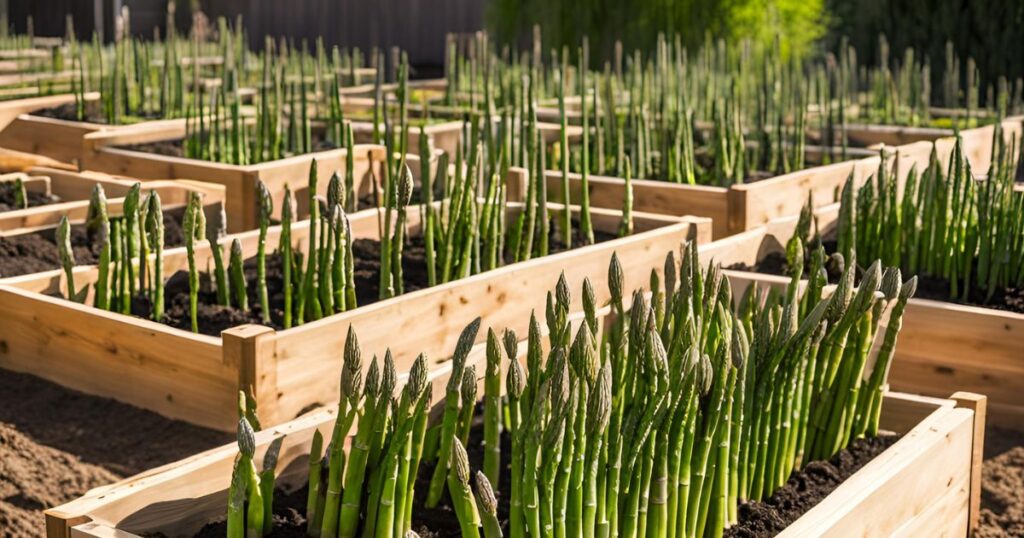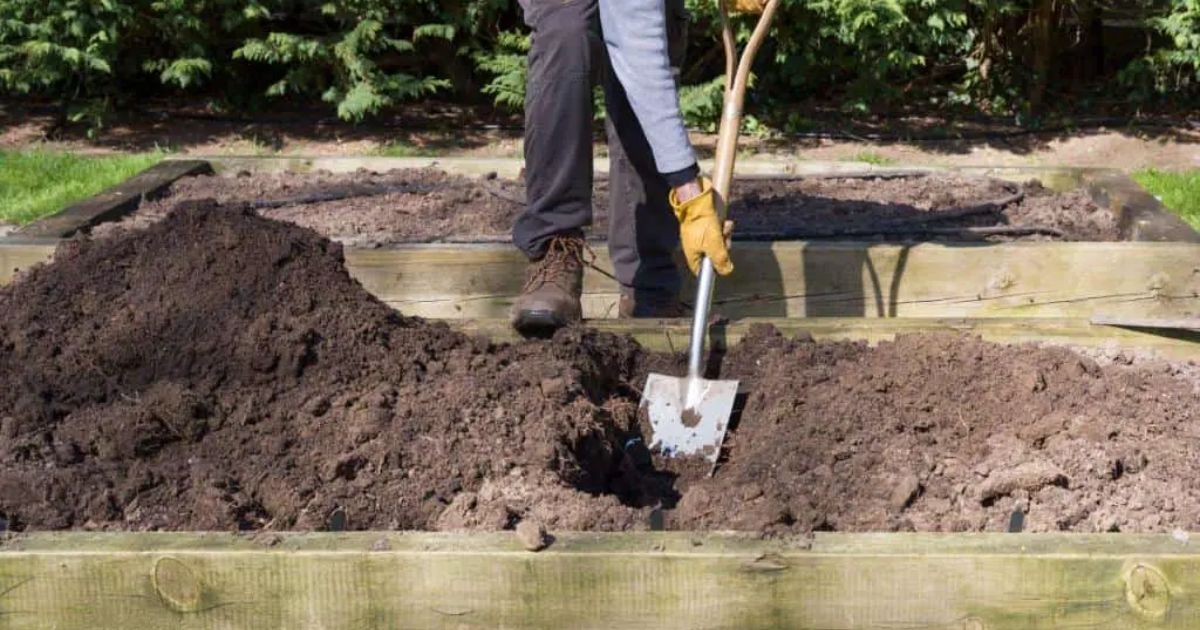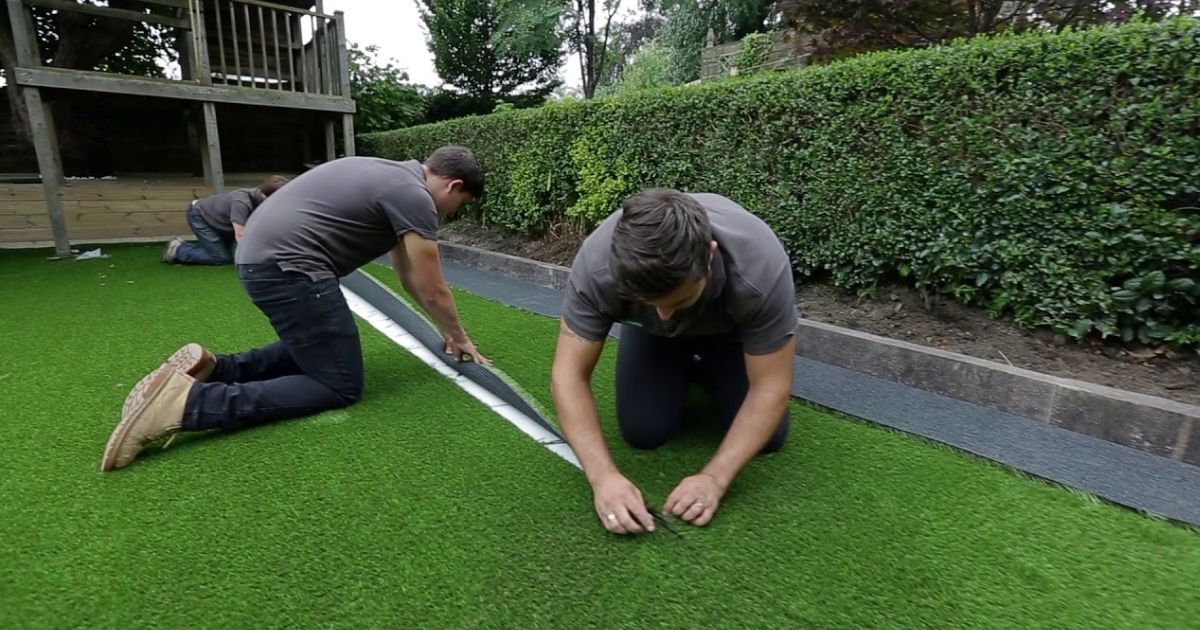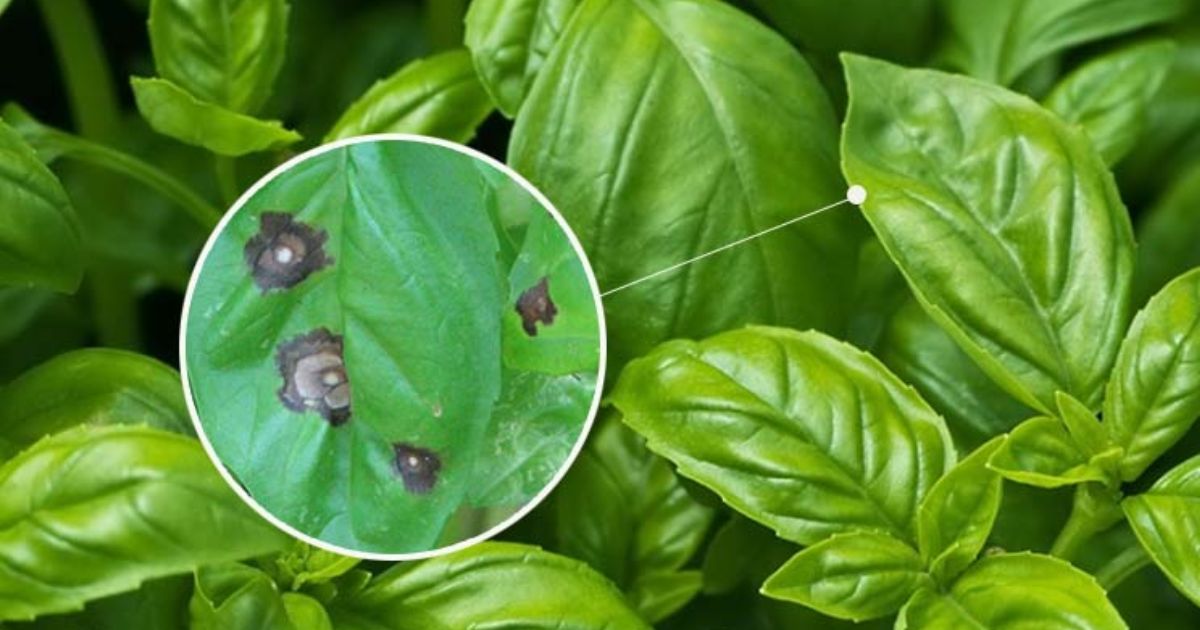Growing asparagus in raised beds offers an ideal solution for home gardeners seeking to cultivate this delicious and nutritious perennial vegetable. Raised beds provide better drainage, soil control, and a more convenient gardening experience, making them perfect for asparagus, which can be produced for 15-20 years with proper care. Whether you’re new to gardening or a seasoned pro, growing asparagus in raised beds is a rewarding endeavor that leads to abundant harvests for years to come.
In this guide, Growing Asparagus in Raised Beds: Your Step-by-Step Planting Guide, we’ll walk you through every stage—from preparing the bed and planting asparagus crowns to maintaining and harvesting your crop. By following these practical steps, you’ll set yourself up for long-term success with this hardy vegetable and enjoy a healthy, productive asparagus garden bed season after season.
Why Grow Asparagus in Raised Beds?
The benefitsThe numerous benefits of Growing Asparagus in Raised Beds make this method a popular choice for gardeners seeking healthier plants and larger yields. Raising asparagus in a raised bed offers several key advantages, including improved drainage, enhanced soil control, and easier maintenance, all essential for the long-term success of growing asparagus.
The primary advantage of elevated beds is better drainage. Asparagus plants are prone to root rot if the soil stays too wet and raised beds naturally help excess water drain away, preventing waterlogged conditions. This is especially useful when gardening in areas with heavy clay or poorly draining soil.
Another major advantage is soil control. Asparagus raised bed allow you to customize your soil mix, ensuring it is rich in organic matter and nutrients, which asparagus requires for robust growth. The pH of the soil is also easily adjustable to suit asparagus, which prefers a slightly acidic to neutral range (6.5-7.5). Controlling the soil quality can provide the perfect environment for your asparagus plants to thrive.
Additionally, asparagus raised bed garden simplify the gardening process. They reduce weed competition and make it easier to manage pests, keeping asparagus healthier. Maintenance tasks like weeding, watering, and fertilizing become more accessible due to the elevated height of raised beds, making this method especially beneficial for gardeners with limited mobility.
Finally, raised beds help extend the growing season by accelerating the springtime warming of the soil. Asparagus is an early-spring crop, and raised beds absorb and retain more heat than ground-level gardens, allowing for earlier planting and faster growth. This advantage can lead to a longer harvest period and a stronger asparagus crop overall.
In short, the benefits of growing asparagus in raised beds include optimal drainage, better soil quality, and extended growing seasons—all of which contribute to a healthier and more productive asparagus garden.
Choosing the Right Location for Your Raised Bed
When growing asparagus, choosing the best location is critical for a healthy, thriving crop. Asparagus is a sun-loving plant, so selecting a spot that receives full sun is essential. Your raised bed asparagus should be placed in an area with at least 6-8 hours of direct sunlight daily. This ensures the plants can produce strong, healthy spears, maximizing your harvest over the years.
In addition to sunlight, asparagus prefers slightly acidic, soil that has good drainage and a pH of 6.5 to 7.5. Raised beds are perfect for asparagus because they allow you to amend and control soil quality easily. Proper drainage is key; asparagus roots do not tolerate soggy conditions and can develop root rot in poorly drained soil. Raised beds naturally enhance drainage, creating a healthier growing environment.
When selecting the best location for growing asparagus in raised beds, consider practical factors like water access and proximity to pathways for easier maintenance. Being close to a water source will make regular watering more convenient, especially during dry periods or when establishing young plants. Also, think about nearby plants. Asparagus plants can grow tall and create shade, so avoid planting them near sun-loving crops that may suffer from the reduced light.
Finally, placing your raised bed near pathways or in an accessible part of your garden makes performing routine tasks such as weeding, mulching, and harvesting easier. Since asparagus is a long-term crop that will remain in the same location for many years, Selecting the ideal site from the outset will set the stage for a productive and low-maintenance asparagus bed.
Preparing the Raised Bed for Asparagus Planting

Proper preparation of your raised bed is essential to ensure healthy growth and long-term productivity of your asparagus spacing raised bed plants. Preparing raised beds for asparagus starts with selecting the right size and ensuring the soil meets the plant’s needs.
Ideal Raised Bed Size
A raised bed about 4 feet wide and 10-12 inches deep is ideal for asparagus. The width allows you to comfortably reach the bed from either side without stepping on the soil, preventing compaction around the asparagus roots. The depth provides sufficient room for the deep root system of asparagus to establish and thrive over the years Growing Jerusalem Artichokes.
Soil Requirements
Asparagus requires well-draining, fertile soil that is rich in organic matter. Because raised beds provide improved drainage and keep preventing water from accumulating around the roots, which may lead to root rot, they are ideal. For asparagus spacing raised bed roots to spread out and penetrate deeply, the soil should be loose and friable.
Amending the Soil with Compost and Organic Matter
In order to prepare the soil for asparagus growth, it is necessary to add a lot of organic matter to the soil and fill it with nutrients. It’s crucial to modify the soil with compost or well-rotted manure before planting. These organic materials improve the soil’s fertility and enhance its structure, ensuring good drainage while retaining enough moisture for the plants.
Incorporating compost also boosts microbial activity in the soil, creating a healthy environment for your asparagus crowns to establish. Aim for roughly 50% garden soil, 25% compost, and 25% sand or other drainage-improving materials.
Soil pH and Adjustments
Soil with a pH of 6.5 to 7.5 is ideal for asparagus; neutral soil does not work well for this plant. It is crucial to correct the pH of your soil before planting if it is not within this range. You can use a pH test kit at home or send a sample of your soil to a local extension office for analysis.
- To increase the pH and make the soil more alkaline, think about adding garden lime.
- To lower pH levels and raise acidity, add sulfur or peat moss to the soil.
Preparing your raised bed with the right soil preparation for asparagus is crucial for establishing a healthy and productive crop. Focusing on the right bed size, enriching the soil with organic matter, and maintaining the correct pH will create an optimal environment for your asparagus to thrive for many years.
Planting Asparagus in Raised Beds: Step-by-Step Guide

Planting asparagus in raised bed is a straightforward process, but it’s important to follow the right steps to ensure your plants establish well and produce bountiful harvests for years. In this step-by-step guide on how to grow asparagus in a raised bed, we’ll walk you through the essential stages of planting asparagus crowns.
Step 1: Choose Between Asparagus Crowns or Seeds
When planting asparagus, you have two options: asparagus crowns (1-2-year-old plants) or seeds. While seeds can be economical, they take several years to mature. For faster results, it’s recommended to plant asparagus crowns. Crowns are already partially established, meaning you’ll likely see your first harvest in about 2-3 years instead of waiting 4-5 years with seeds.
Step 2: Dig Trenches in the Raised Bed
To begin planting, dig trenches in your raised bed that are 12-18 inches apart and about 6-8 inches deep. These trenches will serve as the planting rows for your asparagus crowns. The spacing is important to give the asparagus plants enough room to grow without overcrowding and ensure they receive plenty of nutrients and sunlight.
Step 3: Plant Asparagus Crowns
Place each asparagus crown in the trench, making sure the roots are spread out evenly, and the buds are facing upward. Space the crowns about 12-18 inches apart within the trench. Once the crowns are in place, cover them with about 2 inches of soil, leaving the rest of the trench open for the next step.
Step 4: Gradually Fill the Trench as Shoots Grow
As the asparagus shoots grow, gradually fill the trench with soil. This process should be done over time, adding soil little by little until the trench is filled. The trench should be filled when the shoots reach about 4-6 inches in height. This gradual filling encourages strong root development and helps the asparagus plants establish firmly in the bed.
Step 5: Water Well and Maintain Moisture
Water the asparagus crowns well after planting to help the soil settle and make sure the roots get enough of moisture. During the growing season, maintain a constant moisture content in the soil, without going overboard. Raised beds naturally provide good drainage, but regular watering is still necessary, especially during dry spells. Proper moisture levels are key to healthy asparagus growth.
By following these five simple steps on how to plant asparagus in raised beds, you’ll create a solid foundation for a productive asparagus garden. Planting asparagus crowns offers a head start on growth, and with the right care, your plants will provide delicious, tender spears for many years to come.
Caring for Asparagus Plants in Raised Beds
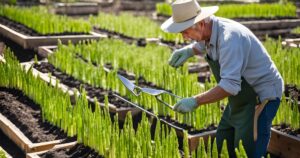
Once your asparagus is planted, proper care is essential to ensure strong growth and bountiful harvests year after year. Raised beds simplify some aspects of maintenance, but asparagus still requires attention in key areas like watering, weeding, fertilizing, mulching, and pest control.
Watering
Asparagus plants need consistent watering, particularly during their first two years when they’re establishing their root systems. During this period, it’s crucial to keep the soil evenly moist but not soggy. The soil tends to dry out in raised beds faster than in-ground gardens, so regular watering is essential. Watering deeply and sparingly promotes the establishment of deep roots, whereas ensuring the beds are well-drained to prevent waterlogging. Once established, asparagus becomes more drought-tolerant, but maintaining good moisture levels will still support optimal growth and Top Tips for Winter Vegetable Storage.
Weeding
Although raised beds reduce weed pressure, some manual weeding will still be necessary around your asparagus plants. Keeping the beds weed-free is important since weeds compete with asparagus for nutrients, water, and sunlight. Hand-pulling weeds is the best approach to avoid disturbing the delicate asparagus roots. It’s especially important to stay on top of weeding during the early years when the plants are developing.
Fertilizing
Asparagus is a heavy feeder, so applying a balanced fertilizer or compost annually in early spring can provide the nutrients it needs for robust growth. Fertilizers that are balanced (10-10-10) or well-rotted composts replenish the soil with nutrients like potassium, phosphorus, and nitrogen. If you fertilize your asparagus plants early in the growth season, they will be more resilient and able to yield big, robust spears. You can also apply another round of fertilizer after the harvest season to support the plant’s continued development.
Mulching
Mulching is an excellent way to care for asparagus plants in raised asparagus bed. Applying a thick moisture-retaining a layer of organic mulch made of leaves, grass clippings, or straw in the soil and suppresses weed growth. Mulch also moderates soil temperature, keeping it cooler in summer and protecting the crowns during winter. Organic materials from the mulch improves the soil as it decomposes, further enriching your asparagus bed.
Pest Control
Asparagus is relatively low-maintenance, but you may still encounter pests, with asparagus beetles being the most common. These beetles feed on the spears and ferns, weakening the plants over time. To manage asparagus beetles, regularly inspect your plants and remove any beetles or larvae by hand. You can also introduce beneficial insects like ladybugs to help control beetle populations. In severe cases, organic insecticidal soap can be used as a treatment, but following label instructions carefully is important to avoid harming your plants.
Following these simple care steps ensures that your asparagus plants thrive in their raised asparagus bed. Regular watering, weeding, fertilizing, mulching, and pest management will contribute to a healthy asparagus crop that provides delicious spears year after year.
Harvesting Asparagus from Raised Beds
Harvesting asparagus from raised asparagus bed is rewarding, but patience is key. One of the most important things to remember is that asparagus should be harvested in the third year after planting. This waiting period allows the plants to establish a strong root system, ensuring healthy growth and higher yields in the long run.
When to Harvest
Once your asparagus plants reach their third year, you can begin harvesting in the spring. The ideal time to harvest is once The spears have a height of six to eight inches and a thickness of around a pencil. Be careful not to let the spears grow too tall, as they can become tough and fibrous. To harvest, cut the spears just above the soil line using a sharp knife or snap them off by hand.
Harvest Window
The harvest window typically lasts 4-6 weeks in the spring. You’ll need to check your asparagus bed daily, as the spears can grow quickly. After the harvest period ends, stop cutting the spears and allow the remaining shoots to grow into tall, fern-like foliage. This foliage helps replenish the plant’s energy for the following season, ensuring continued strong production.
Waiting for the right time and using proper harvesting techniques can ensure a productive asparagus crop for many years.
Maintaining and Extending Your Asparagus Bed’s Lifespan
Asparagus is a long-lived perennial; with proper care, your raised bed can continue producing for 15-20 years or more. Post-harvest care, nutrient replenishment, and occasional crown division are essential practices to maximize the lifespan and productivity of your asparagus bed.
Post-Harvest Care
After the harvest period ends in late spring or early summer, allowing the asparagus spears to grow into tall, fern-like foliage is important. These ferns are crucial for photosynthesis, which helps the plants store energy for the next growing season. In the fall, once the ferns turn yellow or brown, cut them back to just above the soil line. This cleanup reduces the risk of pests and diseases overwintering in the bed, keeping your plants healthy for the following season.
Replenishing Nutrients
Asparagus is a heavy feeder, so it’s important to replenish the soil’s nutrients annually to maintain healthy growth and productivity. After cutting back the ferns in fall or before the new growth begins in spring, apply a generous layer of compost or an organic fertilizer to the bed. This nutrient boost helps the plants build energy reserves for the upcoming growing season. Organic matter like compost also improves soil structure, supporting better root health and drainage.
Dividing Crowns for Longevity
To keep your asparagus bed thriving for decades, consider dividing the crowns every 7-10 years. Over time, asparagus crowns can become overcrowded, which reduces their productivity. To divide the crowns:
- Dig up sections of the plants in the fall after the ferns have died back.
- To separate the, use a sharp knife or spade crowns into smaller sections, each with a healthy root system and buds.
- Replant the divided crowns in the same bed or a new location to ensure continued production.
By caring for your asparagus bed with post-harvest maintenance, annual nutrient replenishment, and periodic crown division, you’ll extend the life of your asparagus plants and enjoy years of abundant harvests.
Conclusion
Growing asparagus in raised beds offers numerous benefits that enhance your gardening experience. The improved drainage, soil control, and ease of maintenance that raised beds provide make them ideal for cultivating this delicious and nutritious perennial. Additionally, the warmer soil temperatures in raised beds can help extend the growing season, ensuring that your asparagus plants thrive from the beginning.
If you’re inspired to start your raised bed asparagus garden, our step-by-step guide provides everything you need to know, from choosing the right location to harvesting your first spears. With a little patience and care, you’ll be rewarded with bountiful harvests for many years.
Now is the perfect time to take action! Consider setting up your raised bed and planting asparagus crowns. If you want more gardening inspiration, check out our related guides on vegetable gardening and raised bed design. We’d love to hear about your experiences with growing asparagus, so feel free to share your thoughts and questions in the comments below! Happy gardening!
FAQs:
1. When can I start harvesting asparagus after planting?
Asparagus should be harvested in the third year after planting. This enables the plants to develop robust root systems, ensuring healthy growth and higher yields.
2. How often should I water my asparagus plants?
Asparagus plants need regular watering, especially during their first two years. Try to maintain a uniformly wet soil but not soggy. Once established, they become more drought-tolerant but still benefit from consistent moisture.
3. What is the ideal size for a raised bed for asparagus?
A raised bed for asparagus should ideally be about 4 feet wide and 10-12 inches deep. This size allows easy access to all plants without compacting the soil.
4. Can I grow asparagus from seeds instead of crowns?
While you can grow asparagus from seeds, it’s recommended to use crowns (1-2-year-old plants) for faster results. Growing from seeds takes longer and requires more care before establishing a productive plant.
5. How do I prepare the soil for my asparagus-raised bed?
Prepare the soil by ensuring it is well-draining and rich in organic matter. Amend the soil with compost and ensure a pH of 6.5-7.5 for optimal growth.

